What will happen if ligaments are cut or broken?
No movements at joints.
Bones will become fixed.
Bones will become unfixed.
Bone will move freely at joints.
Correct Answer :
C. Bones will become unfixed.
Ligaments attach a bone with another bone in movable/ synovial joints. Broken or cut ligaments make movement at joints very painful and restricted. It heals only after prolonged movement restriction.
Related Questions
Figure given below shows reproductive system of female cockroach. The correct labellings indicated by alphabets (A, B & C) are respectively
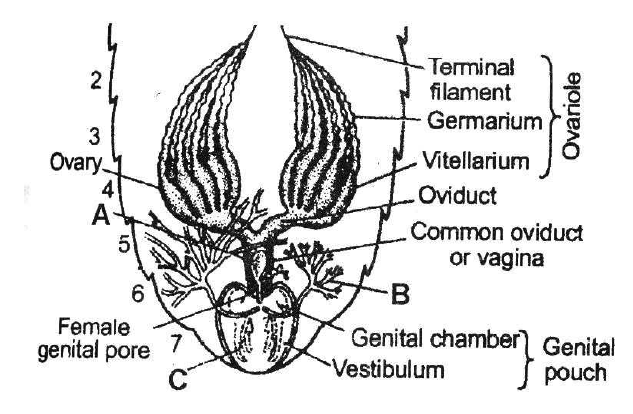
A-Spermatheca, B-Collaterial glands, C-Gonapophyses
A-Phallic gland, B-Collaterial glands, C-Gonapophyses
A-Spermatheca, B-Seminal vesicle, C-Gonapophyses
A-Spermatheca, B-Collateral glands, C-Tegmina
Match the epithetial tissue given in column-I with its location given in column-II and choose the correct option.
| Column I | Column II |
|---|---|
| (Epithelial tissue) | (Location) |
| A. Cuboidal | I. Epidermis of skin |
| B. Ciliated | II. Inner lining of blood vessels |
| C. Columnar | III. Inner surface of gall bladder |
| D. Squamous | IV. Inner lining of fallopian tube |
| E. Keratinized | V. Lining of pancreatic duct squamous |
A V; B IV; C II; D III; E I
A III; B IV; C V; D II; E I
A V; B IV; C III; D II; E I
A III; B IV; C V; D I; E II
Phallic organs in cockroach are related to
male excretory system.
male reproductive system.
female excretory system.
female reproductive system.
Which of the following animal's sensory system does not has eyes but does possess light and touch sensitive organs (receptor cells) to distinguish the light intensities and to feel the vibrations in the ground?
Frog
Snake
Earthworm
Cockroach
The major functions of loose connective tissue include
occupying spaces between organs and supporting epithelia.
supporting and surrounding blood vessels and nerves
cushioning organs, storing lipids and facilitating diffusion.
All of the above
Which of the following statement(s) is/are correct about muscle tissue ?
Each muscle is made of many long, cylindrical fibres arranged in parallel arrays.
Muscle fibres contract (shorten) in response to stimulation, then relax (lengthen) and return to their uncontracted state in a coordinated fashion.
Muscles play an active role in all movements of the body.
All of the above
The figure given below shows the alimentary canal of cockroach with few structures labelled as 1, 2, 3 and 4. Identify the correct identification of the structure which is also called proventriculus and helps in grinding the food particles.
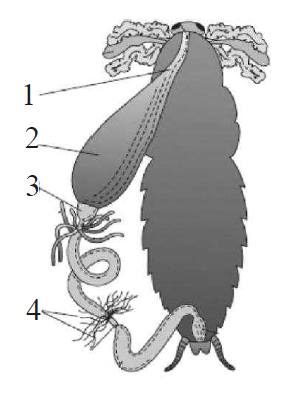
1
2
3
4
Which of the following statement is incorrect regarding cuboidal epithelium ?
It is an epithelial tissue.
It is composed of a single layer of cube-like cells.
They are found in the walls of blood vessels and air sacs of lungs.
Secretion and absorption are the main functions of these tissue.
Smooth muscles are______.
voluntary, branched, uninucleate
voluntary, multinucleate, cylindrical
involuntary, cylindrical, multinucleate
involuntary, spindle shaped, uninucleated, tapering
Statement 1: Typhlosole increases the effective area of absorption in the intestine.
Statement 2: Typhlosole, present in the intestine, is the characteristic feature of cockroach.
Statement 1 and 2 are true and statement 2 is the correct explanation of statement 1.
Statement 1 and 2 are true and statement 2 is not the correct explanation of statement 1.
Both statements 1 and 2 are false.
Statement 1 is true and statement 2 is false.
Which of the following animals maintain ecological balance?
Frog
Rabbit
Earthworm
Cockroach
The given figure shows open circulatory system of cockroach with structure marked as A, B and C. Which structure is a 13 pair of wing shaped involuntary muscles and mantain blood circulation?

A
B
C
Both A nad B
The frog never drinks water but absorbs it through one of its respiratory organ. Identify the organ.
Skin
Lung
Buccal cavity
None of the above.
The diagram given below represents the reproductive organ of male cockroach. Choose the correct labelling of the part of marked as A, B, C and D.
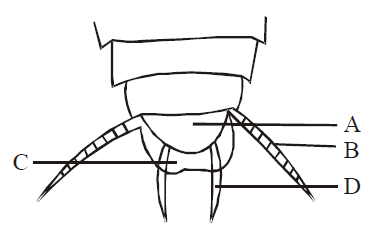
A 8th sternum, B - Anal cercus, C - 10th tergum, D - Anal style
A - 10th tergum, B - Anal cercus, C - Anal style, D - 8th sternum
A - Anal style, B - Anal cercus, C - 10th tergum, D- 8th sternum
A - Anal cercus, B - 8th sternum, C - 10th tergum, D - Anal style.
Consider the following statements regarding cockroach and mark the correct option.
- Head is formed by the fusion of 6-segments.
- Mouth parts are biting and chewing type.
- Crop is the part of mid gut.
Only (ii) is correct
(ii) and (iii) are correct
(i) and (ii) are correct
Only (iii) is correct
Which of the following statement(s) is/are correct regarding respiratory system of cockroach ?
- It consists of a network of trachea, that open through 12 pairs of small holes called spiracles present on the lateral side of the body.
- Thin branching tubes carry oxygen from the air to all the parts.
- The opening of the spiracles is regulated by sphincters.
- Exchange of gases take place at the tracheoles by diffusion.
Only (i)
(i), (ii) and (iii)
(ii), (iii) and (iv)
All of these
Read the following statements and answer the question.
- It is made of a single thin layer of flattened cells with irregular boundaries.
- They are found in the walls of blood vessels and air sacs of lungs.
- They are involved in functions like forming a diffusion boundary.
Which of the following characteristics of tissue is being described by the above statements ?
Squamous epithelium
Columnar epithelium
Ciliated epithelium
Compound epithelium
Statement 1 : Cartilage (protein matrix) and bone (calcium matrix) are rigid connective tissue.
Statement 2 : Blood is connective tissue in which plasma is the matrix.
Statement- 1 and statement-2 are true and statement-2 is a correct explanation for statement -1
Statement -1 and statement-2 are true and statement-2 is not a correct explanation for statement -1
Statement - 1 is true and statement- 2 is false
Both the statements are false.
The chondrocytes of connective tissue are
fibre secreting cells
bone forming cells
cartilage cells
bone eating cells
What are the three basic components of connective tissues?
Ground substance, cells and basement membrane
Cartilage, intercellular matrix and serum
Cells, protein fibers and ground substance
Collagen, elastin and reticular fibers
Identify figures-I and II.

Figure I Figure II
Dense regular Dense irregular connective tissue, connective tissue
Loose irregular Loose regular connective tissue, connective tissue
Adipose tissue, Specialized connective tissue
Connective tissue Areolar tissue proper
The following figure shows the extarnal features of cockroach with few structures labelled as A, B, C, D, & E. Identify A to E .
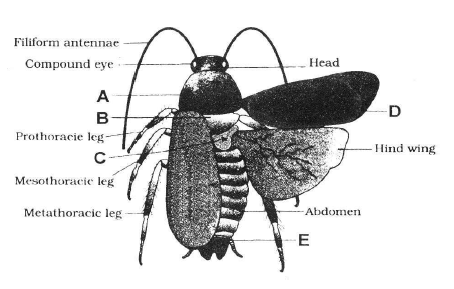
A- Mesothorax, B-Pronotum, C-Metathorax, D-Tegmina, E-Anal style
A- Pronotum, B-Metathorax, C-Mesothorax, D-Tegmina, E-Sterna
A- Pronotum, B-Mesothorax, C-Metathorax, D-Tegmina, E-Anal cerci
A- Pronotum, B-Mesothorax, C-Metathorax, D-Tegmina, E-Anal style
The fibres of which of the following muscles are fusiform and do not show striations
Skeletal muscles
Cardiac muscles
Both (a) and (b)
Smooth muscles
Which of the following statement (s) is/are correct ?
- Loose connective tissue contains fibroblasts, macrophages and mast cells.
- Adipose tissue is a type of dense connective tissue located mainly beneath the skin.
- Tendons and ligaments are examples of dense irregular connective tissue.
- Cartilage, bones and blood are various types of specialized connective tissue.
Only (i)
Both (ii) and (iv)
Both (i) and (iii)
(i), (iii) and (iv)
Tendons and ligaments are the examples of
areolar connective tissue
adipose tissue
dense regular connective tissue
loose connective tissue
What will happen if ligaments are cut or broken?
No movements at joints.
Bones will become fixed.
Bones will become unfixed.
Bone will move freely at joints.
What external changes are visible after the last moult of a cockroach nymph?
Development of anal cerci.
Development of both forewings and hind wings.
Development labium.
Mandibles become harder.
The given figure shows the nephridial system of earthworm and answer the question.
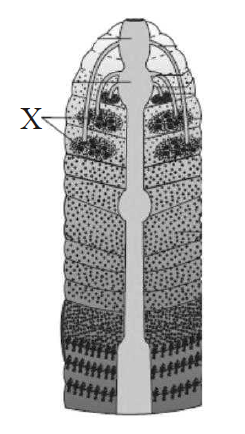
Select the option which shows the correct identification and the function of the structure marked as X.
Lateral heart. It is a blood pumping organ.
Calciferous glands. They neutralize the humic acid present in humus.
Nephridia. It regulates the volume and composition of the body fluids.
Blood glands. They produce blood cells and haemoglobin which is dissolved in blood plasma.
Match the types of connective tissue given in column-I with their examples given column-II and choose the correct option.
| Column-I | Column-II |
|---|---|
| (Types of connective) | (Examples) |
| A. Loose connective | I. Tendons and ligaments tissue |
| B. Dense regular | II. Skin tissue |
| C. Dense irregular | III. Cartilage, bones, blood tissue |
| D. Specialized | IV. Fibroblasts, macrophages connective tissue and mast cells |
A I; B IV; C II; D III
A I; B IV; C III; D II
A IV; B I; C II; D III
A IV; B II; C I; D III
When cardiac muscle cells are damaged by a heart attack, they are usually replaced by
connective tissue cells
new smooth muscle cells
new cardiac muscle cells
epithelial cells
